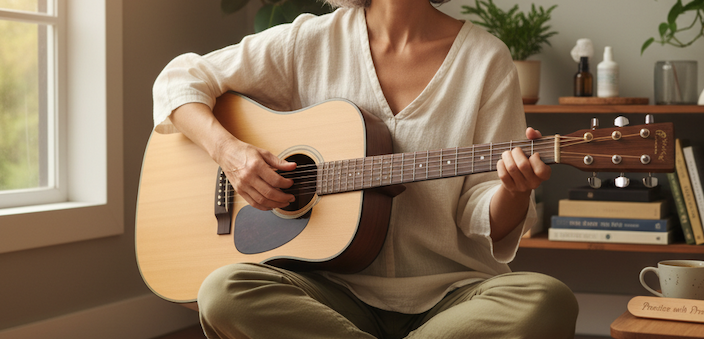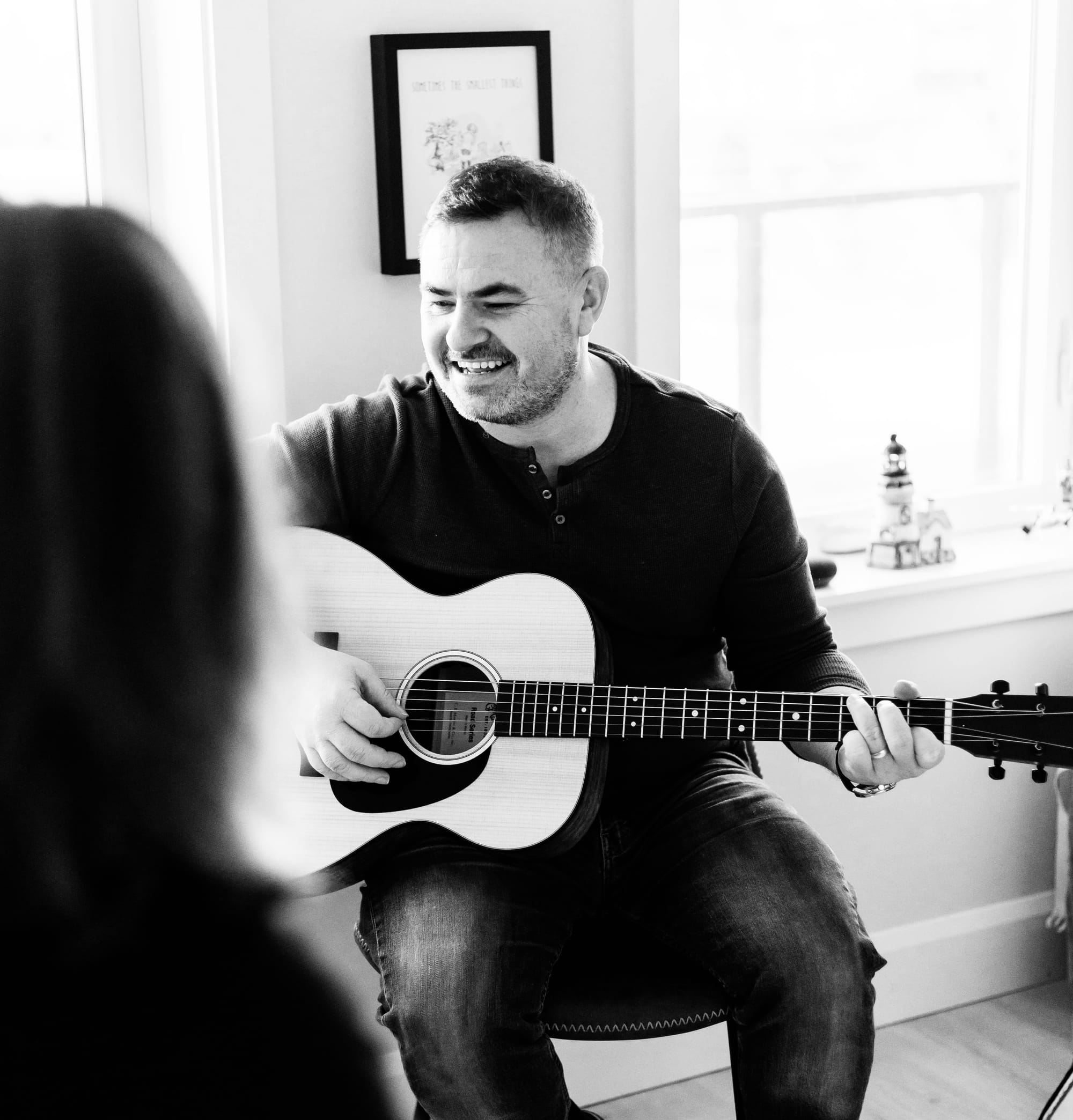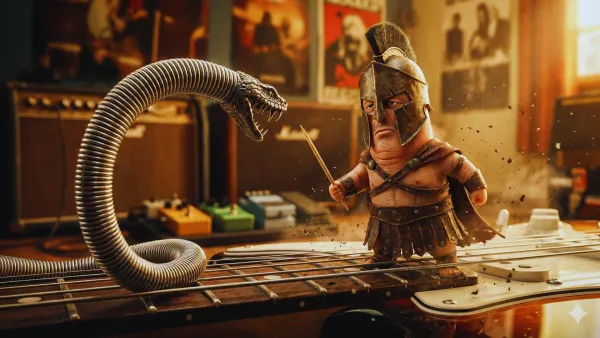The Spine-to-String Connection
Play with less tension. Sit with more ease.

Do you ever catch yourself hunching over your guitar then feel it in your back hours later?
You’re not alone.
Most adult players carry years of physical habits: long days at desks, old injuries, or just the realities of aging. Add a guitar into the mix, and it doesn’t take long for discomfort to creep in.
But posture isn’t about looking perfect. It’s about freeing up your sound.
In this post, I’ll show you a simple, realistic way to sit that protects your spine and improves your playing.
Why Posture Matters More Than You Think
Think of your spine as the main highway for every nerve signal your brain sends to your hands.
When your posture collapses, you’re creating traffic jams (Ylinen et al., 2003). Muscles work harder, nerves fire less efficiently, and fatigue sets in fast.
If your lower back is hunched, your neck and shoulders will overwork to keep you in position and your hands will pay the price.
Pain isn’t random it’s often patterned.
Long before you picked up the instrument, your posture patterns were already likley being shaped by old injuries, desk jobs, heavy lifting, or just the way you sit to relax.
When you sit down to play, those patterns don’t disappear.
They show up as tension, stiffness, or fatigue. And they often get blamed on the wrong thing.
Here’s how that plays out:
- Old habits = collapsed spine, tilted pelvis, locked shoulders
- Guitar position = amplifies imbalances instead of correcting them
- Result = compensations creep in, and pain follows
So the answer isn’t a perfect posture.
It’s realigning how your body meets the instrument so you’re not fighting yourself every time you play.
Poor posture reduces control, limits mobility, and makes your technique feel harder than it should be.
The fix isn’t forcing a “military straight” back. It’s learning to sit in a way that your spine and instrument work together.
4 Common Guitar Posture Mistakes That Strain Your Back
Slouching Into the Guitar
That forward curl feels relaxed, but it compresses your lower back and robs your lungs of space.
Chair & Seat Height Issues
If your hips are lower than your knees, your pelvis tilts back. That’s a shortcut to low-back ache.
Reaching Too Far for the Neck
Stretching forward twists your spine and loads your discs unevenly — a recipe for stiffness.
Shoulder and Neck Creep
If your shoulders are trying to kiss your ears, it’s time for a break.
So whats the right way to sit?
A Grounded Way to Sit (That Doesn’t Feel Rigid)
1. Start with your feet
- Flat on the floor
- Hips level or slightly above knees
- Sit bones grounded, not tucked
2. Tilt the guitar towards you
- Use a footstool or low cushion under the neck-side foot
- Angle the guitar slightly upward so it leans in — not out
- This keeps your spine upright without forcing it
3. Relax the shoulders
- Let them drop away from your ears
- Elbows hang loosely, not pinned
- Avoid the “chicken wing” flare — it adds unnecessary tension
4. Check your spine and neck
- Gentle curve, not military stiff
- Think of your crown lifting slightly — like someone pulling a string upward from the top of your head
- Neck should feel long, not craned forward
Bonus tip: Place a small pillow or wedge behind your lower back if you’re sitting for long sessions. It’ll reduce passive slouch.
Your back doesn’t care how great your solo is if you’re slouching, it’s filing a complaint.
How Better Posture Improves Playing
When your spine is neutral, your breathing opens up. You last longer without fatigue, and if you sing, your voice gets steadier.
A balanced spine means your hands can work without fighting the rest of your body. Blood flow improves. Nerve signals are clear.
The result? Cleaner fretting, smoother strumming, and fewer “my hands just won’t do it today” moments.
When to Seek Professional Help
If pain lingers beyond a week, spreads to your arms or legs, or affects daily activities, it’s time for an assessment.
An osteopath, physio, or music-focused health practitioner can spot habits you don’t notice and give you custom fixes.
Conclusion: Your Back Is Part of Your Sound
Your spine isn’t just holding you up. It’s shaping your tone, your stamina, and your ability to lose yourself in the music.
One adjustment today could mean ten more years of pain-free playing. So sit tall, breathe deep and let your spine be part of your sound.
Your turn: What’s one posture habit you’ve changed that made your playing easier? Share it someone else might need to hear it.
You'll learn:
- The 7 Pillars of Guitar Posture that actually matter
- How to warm up properly
- Daily hand stretches to prevent tension and overuse
- Fretting and strumming technique that protects your joints
- A repeatable, pain-free practice routine for consistent progress
- Warning signs to look out for before pain becomes injury
F.P

F.P. O’Connor
F.P. O’Connor is a manual osteopath, psychology grad, and lifelong musician who helps adults play with less pain and more confidence.
Through Gentle Octaves Studio, he blends science, movement, and musicianship to help mature players keep creating for life.
Release → Reset → Rebuild™ your sound.
Want the Full system:
FAQ
Q: Is it bad to sit on the edge of a couch while playing?
A: It’s not “bad,” but it usually collapses your lower spine and forces the guitar away from your center which makes everything upstream work harder. A firmer chair or supported sitting position keeps your spine upright so your shoulders and hands don’t have to compensate.
This is general playing guidance, not a medical assessment. If you notice back or hand fatigue building fast, your sitting surface is often the first thing to fix.
Q: Should I use a footstool or a strap when I’m sitting down?
A: Both are valid. The real goal is a guitar that doesn’t drift, slide, or force you to chase it with your spine. A footstool can raise the guitar into a better angle; a strap keeps it anchored in the same position whether you’re standing or sitting.If anything you use makes you hunch or twist, adjust it or switch tools.
Q: Can posture really help reduce finger tension?
A: Absolutely. If your spine and shoulders are doing less micro-balancing, your hands stop trying to “hold on for dear life.” A stable base gives your fingers permission to stay lighter and more precise.When the torso is stable, fretting pressure naturally drops, and accuracy improves without forcing it.
Q: How do I know if my posture is causing tension when I play?
A: Look for signs like shoulder lifting, neck creeping forward, lower-back rounding, or constantly shifting in your seat. Those are strong indicators your spine isn’t supported and your hands are doing extra work.
If tension spikes quickly or spreads up the arm/neck, take a short break and reset your sitting position.
Q: What’s the best sitting posture for long guitar practice sessions?
A: Aim for:
- Feet flat
- Hips level
- Spine tall but relaxed
- Guitar close to your centerline
- Shoulders resting, not reaching
Good posture isn’t rigid, it’s balanced enough that your hands move freely.
Q: Does slouching actually affect my tone or accuracy?
A: Indirectly, yes. When your torso collapses, your reach changes, your fretting hand works harder, and your picking angles shift. Players often describe slouch-induced tension as “fighting the guitar.”
Q: What’s the biggest posture mistake adult guitarists make?
A: Leaning forward to see the fretboard.
It rounds the spine, tightens the neck, and overworks the fretting hand.
Lift the guitar slightly or adjust your angle instead of chasing it.
Q: Is standing better than sitting for reducing tension?
A: Not always standing removes the slouch risk, but it adds load to the shoulders if your strap height is off. The best position is the one that keeps your spine neutral and your guitar stable.
Q: Do I need perfect posture to play without pain?
A: No- you need functional posture, not military posture.
If the guitar stays close, your spine is supported, and your shoulders are resting, that’s enough for most players.
Sources & Science
Lee, H. S., Park, H. Y., Yoon, J. O., Kim, J. S., Chun, J. M., Aminata, I. W., Cho, W. J., & Jeon, I. H. (2013). Musicians' medicine: musculoskeletal problems in string players. Clinics in orthopedic surgery, 5(3), 155–160. https://doi.org/10.4055/cios.2013.5.3.155
Ohlendorf, D., Wanke, E. M., Filmann, N., Groneberg, D. A., & Gerber, A. (2017). Fit to play: posture and seating position analysis with professional musicians - a study protocol. Journal of occupational medicine and toxicology (London, England), 12, 5. https://doi.org/10.1186/s12995-017-0151-z
Ohlendorf, D., Maurer, C., Bolender, E., Kocis, V., Song, M., & Groneberg, D. A. (2018). Influence of ergonomic layout of musician chairs on posture and seat pressure in musicians of different playing levels. PloS one, 13(12), e0208758. https://doi.org/10.1371/journal.pone.0208758
Ylinen, J., Takala, E. P., Nykänen, M., Häkkinen, A., Mälkiä, E., Pohjolainen, T., Karppi, S. L., Kautiainen, H., & Airaksinen, O. (2003). Active neck muscle training in the treatment of chronic neck pain in women: a randomized controlled trial. JAMA, 289(19), 2509–2516. https://doi.org/10.1001/jama.289.19.250





